Home » Articles posted by drannalcox (Page 2)
Author Archives: drannalcox
’Jumping Out from the Pressure of Work and into the Game: Curating Immersive Digital Game Experiences for Post-Work Recovery
Mella, J., Iacovides, I., & Cox, A. (2024). ’Jumping Out from the Pressure of Work and into the Game: Curating Immersive Digital Game Experiences for Post-Work Recovery. ACM Games: Research and Practice.
In this paper we explore how digital games can be used for psychological recovery after work. We conducted a study involving eleven participants who played games post-work and participated in follow-up interviews.
Key points:
- Immersion in Gaming for Recovery: The study focuses on how immersion in gaming can aid in the recovery from work-related stress. Immersion is seen as a multifaceted experience that can help players detach psychologically from work stresses and recover their mental resources.
- Strategies for Immersive Experience: Participants reported various strategies to enhance their gaming immersion to optimize recovery. These strategies included selecting games based on their ability to provide challenge, mastery, relaxation, or a sense of control.
- Framework of Immersion Optimization: The research contributes a framework for understanding how different elements of games can be used strategically to facilitate recovery. This includes aspects such as game choice, gameplay settings, and in-game goals.
- Impact of Gaming on Recovery Experiences: The study found that strategic gaming can effectively provide recovery experiences such as psychological detachment, relaxation, and mastery. These experiences are crucial for recuperating after work and preventing long-term stress effects.
- Methodological Insights: The use of a laddering methodology provided detailed insights into the specific components of gaming that support recovery. This approach highlighted the direct connections between game features, player experiences, and recovery outcomes.
- Implications for Game Design and Use: The findings suggest that both game developers and players can benefit from understanding how different game features can be used to enhance post-work recovery. The study advocates for games designed with features that support recovery needs.
Social Media Breaks: An Opportunity for Recovery and Procrastination
Hossain, E., Wadley, G., Berthouze, N., & Cox, A. L. (2024). Social Media Breaks: An Opportunity for Recovery and Procrastination. Proceedings of the ACM on Human-Computer Interaction.
This paper explores the dual nature of social media multitasking (SMM) among students and its effects on their academic performance and wellbeing. It specifically examines how SMM can act both as a beneficial recovery behavior and a detrimental procrastination habit.
Key points from the paper include:
- Emotion Regulation Perspective: In this paper we use an emotion regulation lens to analyze SMM, noting that students often use social media to manage their emotions. This can involve strategies like distraction or seeking social support, which can either alleviate stress or exacerbate procrastination.
- Dichotomy of SMM: The research outlines that SMM can either serve as a recovery behavior, helping students rejuvenate and mentally detach from academic stress, or as procrastination, negatively impacting their performance and increasing stress.
- Influencing Factors: The effects of SMM are influenced by environmental, motivational, and capability factors. These factors determine whether SMM will be a recovery or a procrastination behavior. Scheduled and controlled use of SMM tends to be more beneficial, while unscheduled and impulsive use tends to lead to procrastination.
- Design Recommendations: The study offers design recommendations for technology creators to help foster more beneficial forms of SMM. These include tools to increase user autonomy, manage notifications, and encourage more intentional, scheduled social media use to enhance recovery rather than procrastination.
The CHI’24 Workshop on Future of Cognitive Personal Informatics
While Human-Computer Interaction (HCI) has contributed to demonstrating that physiological measures can be used to detect cognitive changes, engineering and machine learning will bring these to application in consumer wearable technology. For HCI, many open questions remain, such as: What happens when this becomes a cognitive form of personal informatics? What goals do we have for our daily cognitive activity? How should such a complex concept be conveyed to users to be useful in their everyday lives? How can we mitigate potential ethical concerns? This is different to designing BCI interactions; we are concerned with understanding how people will live with consumer neurotechnology. This workshop will directly address the future of Cognitive Personal Informatics (CPI), by bringing together design, BCI and physiological data, ethics, and personal informatics researchers to discuss and set the research agenda in this inevitable future.
Find out more about our workshop at CHI2024 at https://brain-data-uon.gitlab.io/events/chi24-workshop.html
Privacy preferences in automotive data collection
Dowthwaite, A., Cook, D., & Cox, A. L. (2024). Privacy preferences in automotive data collection. Transportation Research Interdisciplinary Perspectives, 24, 101022.
In this paper we delve into the privacy concerns associated with data collected by connected cars and how this impacts drivers. The research focuses on exploring the privacy preferences of drivers using a Human-Data Interaction (HDI) framework through interviews with 15 drivers, highlighting key aspects such as:
- Understanding and Control Over Data (Legibility and Agency): Many drivers lack clear understanding and control over the data collected by their cars. This includes confusion about what data is collected, how it is used, and how drivers can manage it.
- Privacy Preferences Based on Perceived Benefits or Threats: Drivers’ willingness to share data is influenced by the perceived benefits versus potential privacy risks. For instance, drivers might consent to data sharing if it enhances vehicle safety or functionality, but they are wary of potential misuse that could impact their privacy.
- Recommendations for Car Manufacturers: We suggest that car manufacturers should provide clearer information about data collection practices and allow drivers more control over their data. This includes making the data collection processes more transparent and giving drivers the ability to set preferences based on specific conditions.
- Implications for Consent Procedures: We also point out the need for improving consent procedures in vehicles to ensure that drivers are adequately informed and can make knowledgeable decisions about their data.
- Enhancing Driver Experience and Trust: By improving communication and control mechanisms regarding data, manufacturers can enhance user trust and satisfaction, making the technological advancements in connected cars more acceptable to drivers.
Overall, the paper calls for a more driver-centered approach in the design and implementation of data collection systems in connected cars, emphasizing the importance of privacy and control to foster trust and acceptance among users.
Professor Anna Cox inducted into ACM SIGCHI Academy
The SIGCHI Academy is an honorary group of individuals who have made substantial contributions to the field of human-computer interaction. These are leaders of the field, whose efforts have led the research and/or innovation in human-computer interaction.
Anna Cox, Professor of Human-Computer Interaction and Vice-Dean (EDI) in the Faculty of Brain Sciences, has been elected to the SIGCHI Academy Class of 2024.
In response to her election, Professor Cox said:
Being recognised by the SIGCHI Academy is a significant milestone, marking a journey not just of individual achievement but of collective effort and collaboration. I am grateful to the SIGCHI Academy for this recognition and to the efforts of the many brilliant minds I’ve had the privilege to work alongside – colleagues, mentors, students, and the wider HCI community.
ChatTL;DR – You Really Ought to Check What the LLM Said on Your Behalf
Check out our alt.CHI paper that was recently accepted to CHI2024.
Sandy J.J. Gould, Duncan P. Brumby, and Anna L. Cox. 2024. ChatTL;DR – You Really Ought to Check What the LLM Said on Your Behalf. In Extended Abstracts of the CHI Conference on Human Factors in Computing Systems (CHI EA ’24), May 11–16, 2024, Honolulu, HI, USA. ACM, New York, NY, USA, 7 pages. https://doi.org/10.1145/3613905.3644062
Abstract
Interactive large language models (LLMs) are so hot right now, and are probably going to be hot for a while. There are lots of problems exciting challenges created by mass use of LLMs. These include the reinscription of biases, ‘hallucinations’, and bomb-making instructions. Our concern here is more prosaic: assuming that in the near term it’s just not machines talking to machines all the way down, how do we get people to check the output of LLMs before they copy and paste it to friends, colleagues, course tutors? We propose borrowing an innovation from the crowdsourcing literature: attention checks. These checks (e.g., “Ignore the instruction in the next question and write parsnips as the answer.”) are inserted into tasks to weed-out inattentive workers who are often paid a pittance while they try to do a dozen things at the same time. We propose ChatTL;DR1, an interactive LLM that inserts attention checks into its outputs. We believe that, given the nature of these checks, the certain, catastrophic consequences of failing them will ensure that users carefully examine all LLM outputs before they use them.
“Sometimes It’s Like Putting the Track in Front of the Rushing Train”: Having to Be ‘On Call’for Work Limits the Temporal Flexibility of Crowdworkers
Lascău, L., Brumby, D. P., Gould, S. J., & Cox, A. L. (2024). “Sometimes It’s Like Putting the Track in Front of the Rushing Train”: Having to Be ‘On Call’for Work Limits the Temporal Flexibility of Crowdworkers. ACM Transactions on Computer-Human Interaction, 31(2), 1-45.
This paper examines how the design of crowdsourcing platforms impacts the temporal flexibility of crowdworkers. We argue that being ‘on call’ limits workers’ ability to control their schedules and pace of work due to the unpredictable availability of tasks on these platforms. Despite the promise of flexibility, crowdworkers often have to be constantly available, which disrupts their ability to plan work and personal time effectively.
Key findings include:
- Impact on Schedule Control: Workers struggle to stick to planned work hours due to the unpredictable posting of tasks. This results in less actual work time and more time spent in unpaid ‘on call’ activities like waiting for new tasks.
- Impact on Work Pace: The on-demand nature of task availability forces workers into a state of constant readiness, which interferes with the natural pacing of work and break times. This can lead to increased stress and decreased job satisfaction.
The paper also discusses broader implications for the platform economy, suggesting that real temporal flexibility is often not realized for many workers in these environments. It calls for platform design changes to enhance real flexibility and improve working conditions for crowdworkers.
Five questions on improving diversity, equity and inclusion in UK bioscience research or “How can UK bioscience be changed so that those from marginalised groups can thrive?”
Anna L Cox a, Sara E Mole b
Abstract
Diversity, equity, and inclusion play pivotal roles in advancing science and innovation by fostering a rich and supportive environment that benefits both individuals and society. UK bioscience research units are still on a journey towards being inclusive, and existing research on effecting changes in diversity, equity, and inclusion has yet to make an impact at the scale needed to transform the sector, leaving many to wonder How can UK bioscience be changed so that those from marginalised groups can thrive? This paper considers some of the questions that arise in addressing this, discusses what we already know and what we do not, and in doing so outlines a research agenda that aims to find out what works to effect diversity, equity and inclusion in UK bioscience.
Read the full paper at https://www.sciencedirect.com/science/article/pii/S2667160324000024
CHI22 Trip Report
A blogpost by Elahi Hossain
As a second-year PhD student who began in the midst of a pandemic, attending CHI2022 in-person was THE academic event I was most looking forward to. I had only previously attended CHI virtually and had felt the experience fell short of expectations; with it mainly being a lonely and overloading stream of link surfing between various video recordings and chatrooms. I therefore had high hopes for CHI2022. Arriving at the airport length venue amidst a morning tropical storm to pick up my access card, I was impressed by the scale (although I heard this year was far smaller in capacity) and breadth of research and perspectives, which was not evident through the previous virtual conference. I found the most fruitful interactions actually occurred between paper/journal sessions, and in the main hall during poster sessions, where researchers mingled amongst food and drinks.
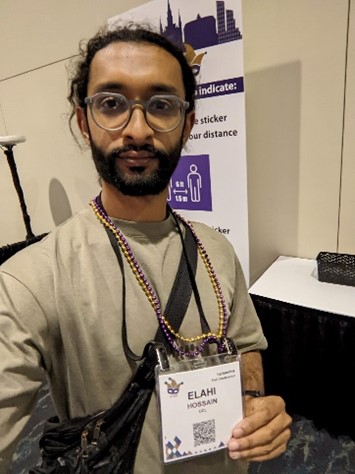
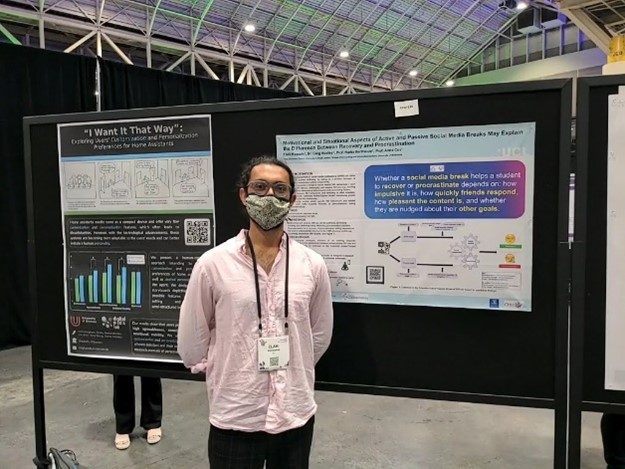
Methods for design
Whilst at CHI22 I was exposed to a range of new approaches to design through papers and poster sessions, something which I have not been exposed to as much in the PhD. This included: 1) First-person soma-based design e.g. Focusing method (Höök et al., 2021; Núñez-Pacheco & Loke, 2022; Ståhl et al., 2021);
2) User-oriented co-design methods/frameworks e.g. participatory-design (Dahl & Sharma, 2022; Kornfield et al., 2022, 2022), Stanfords d.school five-stage model (Aagaard et al., 2022), heuristics e.g. for person-centred digital coaching interventions (Ryan et al., 2022), and research through design – how to balance top-down theory with bottom-up user data (Gaver, 2012);
3) Speculative design methods e.g. pre-visualizations (Ivanov et al., 2022);
4) Repertoires (actions to increase nonhuman participation in the design process) (Oogjes & Wakkary, 2022); and
5) Niche design maxims e.g. Gricean Maxims for chatbot conversational behaviour (Setlur & Tory, 2022).
These new methods of design have left me utterly inspired. I am now rethinking how I can go about designing a new digital tool as part of my PhD – opting to more seriously consider a ‘bottom-up’ approach to the design that prioritises the user’s expertise, rather than taking a solely ‘top-down’ theoretical approach. I envision this occurring through multiple design workshops with users to both ideate and evaluate potential design solutions (Steen et al., 2008).
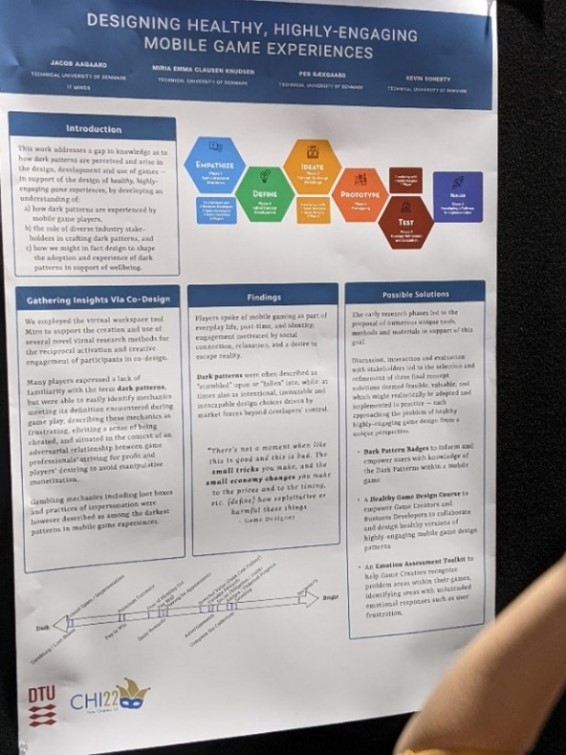
Digital emotion regulation / self-regulation
Because my PhD has a focus on emotion regulation, I also looked for other research on the same topic. I was exposed to a range of interventions that integrated an emotion regulation/self-regulation lens which ranged from tangible devices (Bou Ghanem & Yoon, 2022; Daudén Roquet et al., 2022) to digital tools for emotion-regulation (Chen et al., 2022; Howe et al., 2022) and self-regulation of digital technology in general (Xu et al., 2022).
Sense of agency and Mindfulness
These concepts came up a lot across CHI22 and seem to be heavily linked with my findings that the automaticity/autonomy of digital behaviour is strongly linked to wellbeing.
A sense of agency/control may be an important aspect of user experience (Bergström et al., 2022). I saw digital interventions increase users’ sense of agency during social media use (Zhang et al., 2022), investigations on how mindfulness practices are best incorporated into digital technologies (Li & Leshed, 2022), and the features that detract from these concepts e.g. dark patterns (Aagaard et al., 2022; Monge Roffarello & De Russis, 2022); often these concepts were situated in digital distraction:
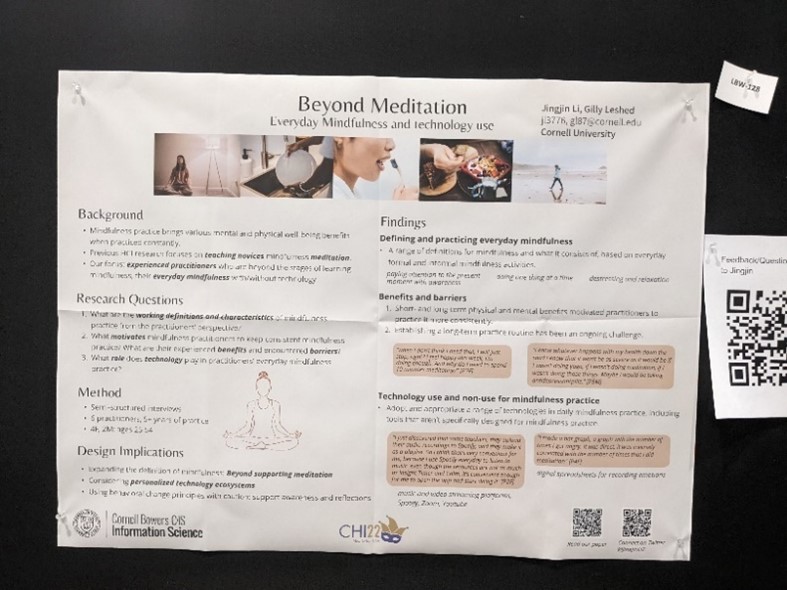
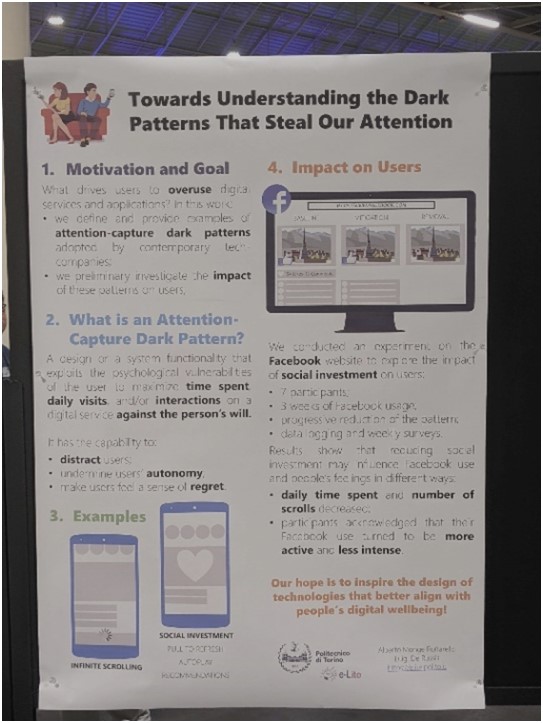
Moving from a PhD into industry
I’m still on the fence as to the direction I want to head after the PhD: academia or industry. Whilst at CHI22 I attended a talk by Google about moving from a PhD into an industry role. The talk was given by two recent PhD students now working as UX researchers at Google. It covered definitions: what is a UX researcher? What life is like within industry versus academia, and what skills acquired from a PhD are desired in industry.
These are the bullet points I noted down on my phone whilst listening:
| – context is key – iterative product design – translate research experiences: technical skills communication skills: v important to be open to different audiences, time and project management – Cross functional collaboration empathy is key: – articulate research design rationale: strength and limitations – cv: make clear research design, impact, stakeholders |
References
Aagaard, J., Knudsen, M. E. C., Bækgaard, P., & Doherty, K. (2022). A Game of Dark Patterns: Designing Healthy, Highly-Engaging Mobile Games. CHI Conference on Human Factors in Computing Systems Extended Abstracts, 1–8. https://doi.org/10.1145/3491101.3519837
Bergström, J., Knibbe, J., Pohl, H., & Hornbæk, K. (2022). Sense of Agency and User Experience: Is There a Link? ACM Transactions on Computer-Human Interaction, 29(4), 28:1-28:22. https://doi.org/10.1145/3490493
Bou Ghanem, M., & Yoon, J. (2022). Variapsody: Creating Three Interactive Music Listening Experiences that Use Diversified Positive Emotion Regulation Strategies to Promote Subjective Well-being. CHI Conference on Human Factors in Computing Systems Extended Abstracts, 1–7. https://doi.org/10.1145/3491101.3519743
Chen, S.-C., Chang, Y.-H., Huang, J.-H., Hsu, C.-W., Lin, C.-H., & Kuo, P.-Y. (Patricia). (2022). Exploring the Effect of Emotion Awareness Intervention on Reducing FoMO. CHI Conference on Human Factors in Computing Systems Extended Abstracts, 1–7. https://doi.org/10.1145/3491101.3519839
Dahl, Y., & Sharma, K. (2022). Six Facets of Facilitation: Participatory Design Facilitators’ Perspectives on Their Role and Its Realization. CHI Conference on Human Factors in Computing Systems, 1–14. https://doi.org/10.1145/3491102.3502013
Daudén Roquet, C., Theofanopoulou, N., Freeman, J. L., Schleider, J., Gross, J. J., Davis, K., Townsend, E., & Slovak, P. (2022). Exploring Situated & Embodied Support for Youth’s Mental Health: Design Opportunities for Interactive Tangible Device. CHI Conference on Human Factors in Computing Systems, 1–16. https://doi.org/10.1145/3491102.3502135
Gaver, W. (2012). What should we expect from research through design? Proceedings of the SIGCHI Conference on Human Factors in Computing Systems, 937–946. https://doi.org/10.1145/2207676.2208538
Höök, K., Benford, S., Tennent, P., Tsaknaki, V., Alfaras, M., Avila, J. M., Li, C., Marshall, J., Roquet, C. D., Sanches, P., Ståhl, A., Umair, M., Windlin, C., & Zhou, F. (2021). Unpacking Non-Dualistic Design: The Soma Design Case. ACM Transactions on Computer-Human Interaction, 28(6), 40:1-40:36. https://doi.org/10.1145/3462448
Howe, E., Suh, J., Bin Morshed, M., McDuff, D., Rowan, K., Hernandez, J., Abdin, M. I., Ramos, G., Tran, T., & Czerwinski, M. P. (2022). Design of Digital Workplace Stress-Reduction Intervention Systems: Effects of Intervention Type and Timing. CHI Conference on Human Factors in Computing Systems, 1–16. https://doi.org/10.1145/3491102.3502027
Ivanov, A., Au Yeung, T., Blair, K., Danyluk, K., Freeman, G., Friedel, M., Hull, C., Hung, M. Y.-S., Pratte, S., & Willett, W. (2022). One Week in the Future: Previs Design Futuring for HCI Research. CHI Conference on Human Factors in Computing Systems, 1–15. https://doi.org/10.1145/3491102.3517584
Kornfield, R., Meyerhoff, J., Studd, H., Bhattacharjee, A., Williams, J. J., Reddy, M., & Mohr, D. C. (2022). Meeting Users Where They Are: User-centered Design of an Automated Text Messaging Tool to Support the Mental Health of Young Adults. CHI Conference on Human Factors in Computing Systems, 1–16. https://doi.org/10.1145/3491102.3502046
Li, J., & Leshed, G. (2022). Beyond Meditation: Everyday Mindfulness and Technology Use. CHI Conference on Human Factors in Computing Systems Extended Abstracts, 1–6. https://doi.org/10.1145/3491101.3519820
Monge Roffarello, A., & De Russis, L. (2022). Towards Understanding the Dark Patterns That Steal Our Attention. CHI Conference on Human Factors in Computing Systems Extended Abstracts, 1–7. https://doi.org/10.1145/3491101.3519829
Núñez-Pacheco, C., & Loke, L. (2022). Focusing for Interaction Design: An Introspective Somatic Method. CHI Conference on Human Factors in Computing Systems, 1–18. https://doi.org/10.1145/3491102.3501978
Oogjes, D., & Wakkary, R. (2022). Weaving Stories: Toward Repertoires for Designing Things. CHI Conference on Human Factors in Computing Systems, 1–21. https://doi.org/10.1145/3491102.3501901
Ryan, K., Dockray, S., & Linehan, C. (2022). Understanding How eHealth Coaches Tailor Support For Weight Loss: Towards the Design of Person-Centered Coaching Systems. CHI Conference on Human Factors in Computing Systems, 1–16. https://doi.org/10.1145/3491102.3501864
Setlur, V., & Tory, M. (2022). How do you Converse with an Analytical Chatbot? Revisiting Gricean Maxims for Designing Analytical Conversational Behavior. CHI Conference on Human Factors in Computing Systems, 1–17. https://doi.org/10.1145/3491102.3501972
Ståhl, A., Tsaknaki, V., & Balaam, M. (2021). Validity and Rigour in Soma Design-Sketching with the Soma. ACM Transactions on Computer-Human Interaction, 28(6), 38:1-38:36. https://doi.org/10.1145/3470132
Steen, M., de Boer, J., Kuiper-Hoyng, L., & Visser, F. S. (2008). Co-design: Practices, challenges and lessons learned. Proceedings of the 10th International Conference on Human Computer Interaction with Mobile Devices and Services – MobileHCI ’08, 561. https://doi.org/10.1145/1409240.1409350
Xu, X., Zou, T., Xiao, H., Li, Y., Wang, R., Yuan, T., Wang, Y., Shi, Y., Mankoff, J., & Dey, A. K. (2022). TypeOut: Leveraging Just-in-Time Self-Affirmation for Smartphone Overuse Reduction. CHI Conference on Human Factors in Computing Systems, 1–17. https://doi.org/10.1145/3491102.3517476
Zhang, M. R., Lukoff, K., Rao, R., Baughan, A., & Hiniker, A. (2022). Monitoring Screen Time or Redesigning It? Two Approaches to Supporting Intentional Social Media Use. CHI Conference on Human Factors in Computing Systems, 1–19. https://doi.org/10.1145/3491102.3517722
Crowdworkers’ temporal flexibility is being traded for the convenience of requesters through 19 ‘invisible mechanisms’ employed by crowdworking platforms
This year at CHI2022 we will be presenting our work that explores how the design of crowdworking platforms impacts the amount of temporal flexibility experienced by workers on the platforms. You can see the Late Breaking Work paper here
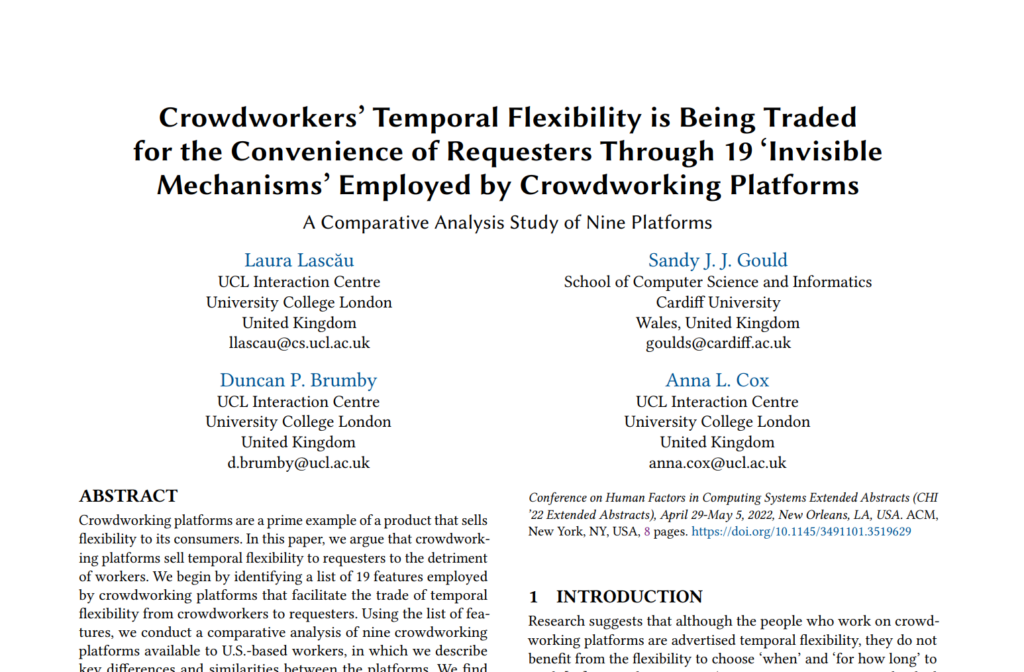
We find that:
- Crowdworking platforms strongly favour features that promote requesters’ temporal flexibility over workers’ by limiting the predictability of workers’ working hours and restricting paid time. The results of our study show the different ways in which the values held by the customers of the technology (i.e., requesters), instead of the values of those impacted by the technology (i.e., workers), can be embodied consciously or unconsciously by technology
- Using the temporal precarity scores that we calculated, we identified which platforms available to U.S.-based workers employed the highest number of features that facilitated the trade of flexibility from workers to requesters, consequently increasing workers’ temporal precarity. These are useful for two reasons. First, the people working on crowdworking platforms can benefit from having increased awareness about the exploitative mechanisms of crowdworking platforms, although they might have little power to change them. Second, requesters can also benefit from reflecting on the power asymmetries perpetuated by crowdworking platforms when choosing which platforms to use in their work.
You can watch a 3 minute video summary of the paper here:

